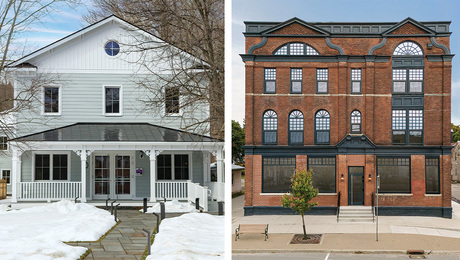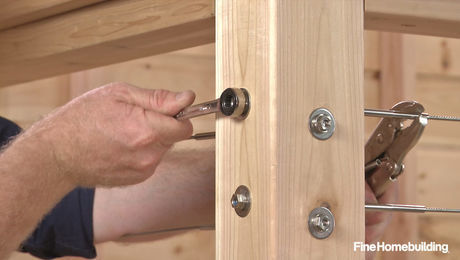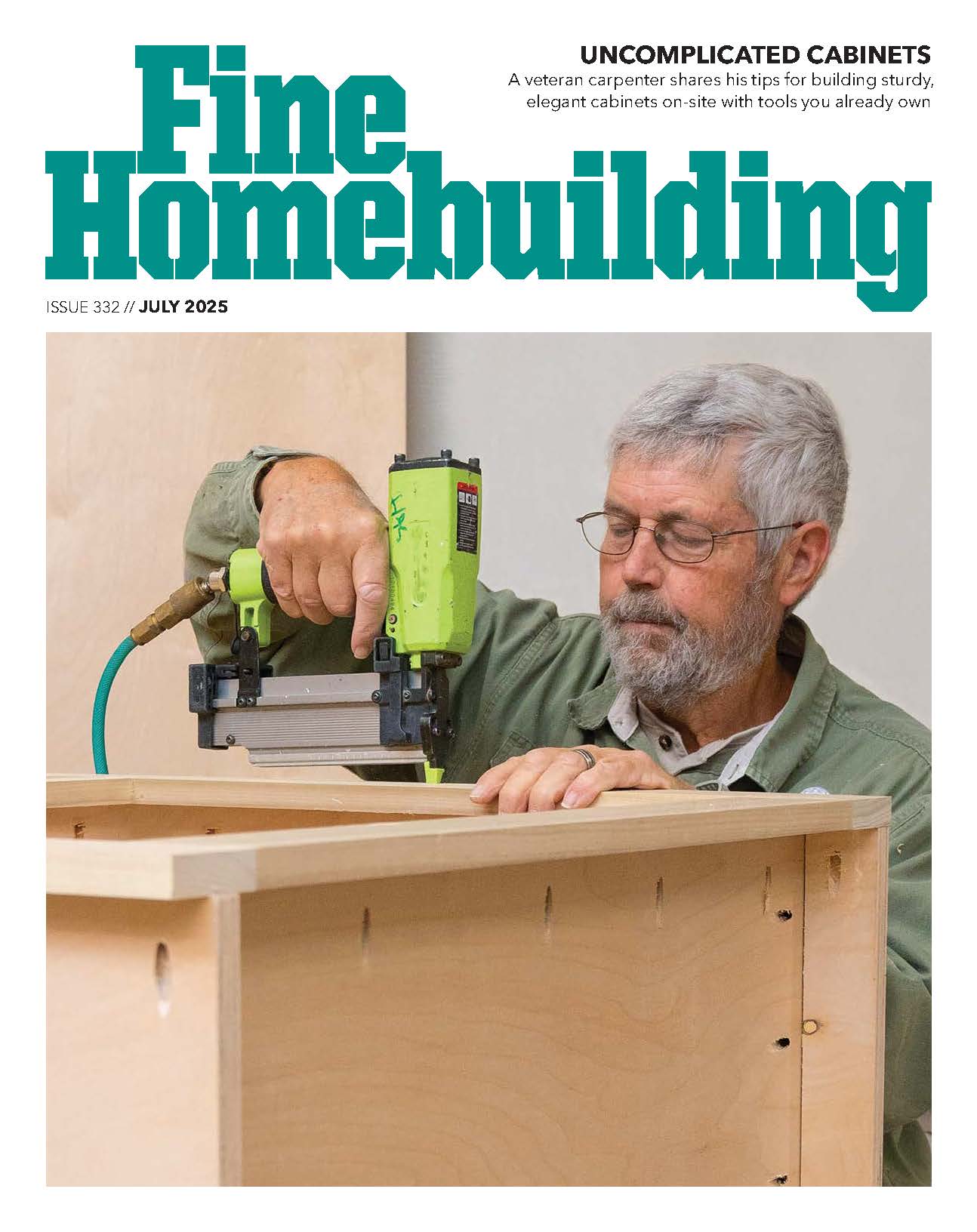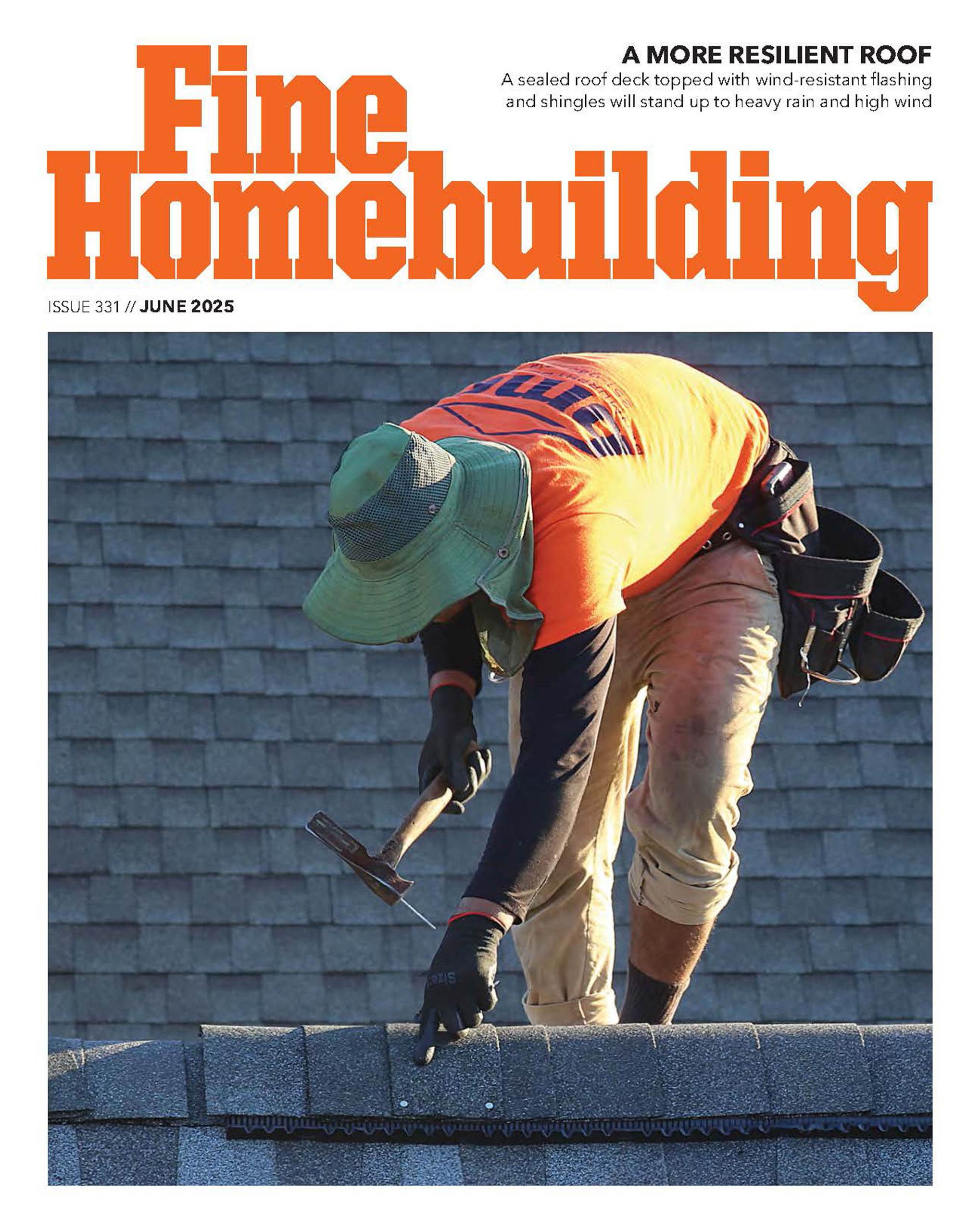*
Building library shelves. 9′ long. One side of room is an inside corner, so can attach shelf side to wall. Other side is outside corner, so no side wall to attach to. Planning ladder-type design discussed in another thread. 1×2 or 1×3 oak or poplar or whatever, topped with glass, melamine, or whatever. Plenty of studs to attach back to. Issue is support for front. Would prefer no visible support, be/c it fits the style of the house better (cantilevers, minimal trim, clean lines, glass), but know that I can’t levitate a 9′ shelf full of books and such. Drawing (front view from below) shows a sample triangular bracket at right. Guidelines on how short the leg against the wall can be and still adequately support weight? Alternately, have you seen any designs that provide minimally-visible support? This will be 4 shelves w/ 2′ clear above floor and 2′ clear at ceiling, so prefer no attachments to either. Thanks!
Discussion Forum
Discussion Forum
Up Next
Video Shorts
Featured Story

A high-performance single-family home builder shares tips from his early experience with two apartment buildings.
Featured Video
How to Install Cable Rail Around Wood-Post CornersHighlights
"I have learned so much thanks to the searchable articles on the FHB website. I can confidently say that I expect to be a life-long subscriber." - M.K.
Fine Homebuilding Magazine
- Home Group
- Antique Trader
- Arts & Crafts Homes
- Bank Note Reporter
- Cabin Life
- Cuisine at Home
- Fine Gardening
- Fine Woodworking
- Green Building Advisor
- Garden Gate
- Horticulture
- Keep Craft Alive
- Log Home Living
- Military Trader/Vehicles
- Numismatic News
- Numismaster
- Old Cars Weekly
- Old House Journal
- Period Homes
- Popular Woodworking
- Script
- ShopNotes
- Sports Collectors Digest
- Threads
- Timber Home Living
- Traditional Building
- Woodsmith
- World Coin News
- Writer's Digest


















Replies
*
I built a cantilevered bookshelf once. I bored horizontal holes into the studs to hold steel pins made from water pipe. The shelves are hollow boxes tall enough to conceal the pins inside -- 1 1/2" tall, as I recall. I fussed around a lot to get the pins exactly horizontal and exactly in line. In retrospect, I think it would be faster to allow a little sloppiness in the installation of the pins, and to use wood shims to develop the level surface to support the shelf.
*Jim, I've done the same as Jamie but since the oak shelving was 3/4" I used 3/8" pins into the studs. As I recall, I used pins into each stud (holes were 3-1/2" deep through sheetrock and about 3" into the oak) and used the shelves for some pretty weighty tomes. I believe the pins were harder than run-of-the-mill cold-rolled steel but that was 30+ years ago sooo...I bored the holes in the oak shelving first and used dowel centers to mark the wall for the corresponding holes and drilled them using one of those jigs that are attached to a drill to hold it perpendicular to the surface. Hopes this helps.
*Jim, this might help your project. Joe H TinaG "How do I do this?" 4/2/00 12:29pm
*Not knowing how deep your shelves are, this may not work, but when I used to build Lindal houses we used a metal bracket to hold up beams in areas where there was no room for anything else. They were about 1/4 inch thich and bent to form an L. You could let the back side into a stud and have only the under support revealed (you could also let it into the shelf and nothing would show) You'd have to patch some drywall though.Your drawing of a knee brace seems a little weak to me...it may be better to get closer to a true 45% if you decide to use it, also I'd fancy it up a bit.
*Good stuff on all fronts. Thanks. Wouldn't you know I searched for "bookshelves" and missed the thread be/c Tina had the nerve to call them just "shelves". :)Will do some thinking now.Prefer cantilever on pins to knee brace. May have to mock one up to see how much it'll hold. I love the kind of building where people say, "How does that hold itself up?!?!" Thanks again. Further ideas still welcome.
*How deep is the shelf to be? If built like a 5 sided box, long and "not tall", maybe around three inches, the depth could get pretty deep ....and if the mounts were on the top, or sides.....the bottom couldn't kick back in.....so it would be pretty ridgid. I made display cubes like this before. About 4 inches projected from wall. 2.5 inches thick/deep/tall (what ever ya wanna call it)...and 6 inches wide. The top surfave was 4x6. Used a keyhole anchor on both sides....and they are rock solid. For something much longer...like the 9 or so feet.....I'd build it the same, and lag a 2x across the wall as a ledger, then slip the shelf over it as a cover, and nail or countersink screws. Bet ya could go about 12 inches from the wall and have a good amount of weight on it. Or, for a thin shelf....I just made a speaker shelf for my livingroom. Just ran a 3/4 dado centered in 1x3 oak, and slipper/glued and screwed the 3/4 oak shelf into it. Then put the screws on the top flange, out of sight. Just floats there. Jeff
*Here's what I'm inclined to try. Ladder-like frame of 1x3 oak, topped w/ 12" deep shelves. Steel pin to support cantilever design ala the first two responses. 1x3 instead of 1x2, following Jeff's logic of the deeper material not allowing the bottom to kick back in when the top has a load (assuming I read it right).Here's the engineering question. I know from doing a cantilevered slab (where the rebar was nearer the top than the bottom of the slab to take advantage of the compressive strength of the concrete) that the pin should be near the top of the 1x3. But oak isn't concrete and won't grip the pin but by friction. Could additionally lag through the oak into the stud to keep the ladder from sliding back off the pin, but where? A screw in middle or bottom of 1x3 won't be as strong as at top, but top already occupied w/ pin. Lag from each side of the pin diagonally up into the stud? Or look for specialty hdw that will lock onto oak w/ more than friction? Or adhesive? Or maybe a screw in the middle of the 1x3 and beneath the pin would be sufficient?Hoping to reduce the number of test shelves to build. At same time, hoping for enough strength that I don't have to tell my DW how to balance the load on the finished shelves. Cheers...Jim
*JimHow about using all-thread for your pins and epoxy it into the studs. If you want the shelves removable, cross-bore a stopped hole with a Forstner bit from below to intersect the pin hole and use a nut or handrail nut. If they are forever, epoxy them to the pins, too. Strong and invisible, provided the goosh-out is handled with masking and due diligence. The Simpson Epoxy-Tie gun is perfect for this. I use it routinely to bond 4x4's to slabs with all-thread, and it sticks just fine to the wood.Bill
*After reading Bucks line, I got an idea that I myself may try next time.......They sell a bracket for mounting newel posts to the floor when putting together a stair system (I think Smith makes them) It's metal, but works like a sliding dovetail. Attach one part to the floor, one to the bottom of the post and slide together. I've used them and they work very well for a post. I'd think they'd work quite well for shelving if it was thick enough.
*look into the Hafele hardware I think I mentioned on that thread; invisible supports, plus there is an eccentric component that lets you level the shelves as well as support them.
*Following Adrian's advice, found http://www.hafeleonline.com/usa/. Called them in--conveniently enough for me--NC. Pronounced HAY-full-a, for what that's worth. The rep will mail info on the closest thing she found to Adrian's description. I'll report back when I see it. She said, "It looks like a rod." Said nothing likely to be on web site. Until I get this, if anyone does better than I did with part names/numbers, it'd be much appreciated. I'll sit tight till I ferret this out. Thanks.
*A long time ago Fine Woodworking had an article on torsion boxes. (Always wanted an excuse to try this, haven't had one) there might be some useful info there.
*Just to make your life harder if you used 1/2" x 1" steel tube 3/32" wall. You would triple your strength, I would drill two 1/2" holes then sharpen the end of a test pice and hammer it in, pull it out add epoxy and set the finished tube in, the hole will be tight enough to level the tube with a simple jig screwed to the wall. When the shelf is up you can screw in to the steel from the top just predrill and go!
*
Building library shelves. 9' long. One side of room is an inside corner, so can attach shelf side to wall. Other side is outside corner, so no side wall to attach to. Planning ladder-type design discussed in another thread. 1x2 or 1x3 oak or poplar or whatever, topped with glass, melamine, or whatever. Plenty of studs to attach back to. Issue is support for front. Would prefer no visible support, be/c it fits the style of the house better (cantilevers, minimal trim, clean lines, glass), but know that I can't levitate a 9' shelf full of books and such. Drawing (front view from below) shows a sample triangular bracket at right. Guidelines on how short the leg against the wall can be and still adequately support weight? Alternately, have you seen any designs that provide minimally-visible support? This will be 4 shelves w/ 2' clear above floor and 2' clear at ceiling, so prefer no attachments to either. Thanks!